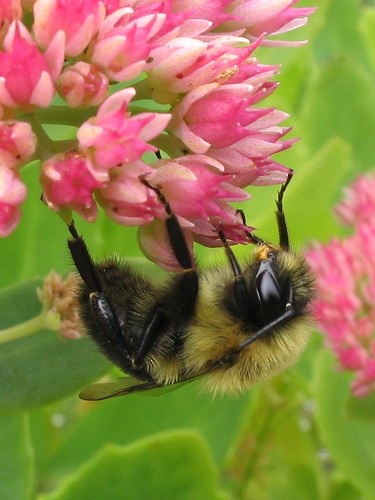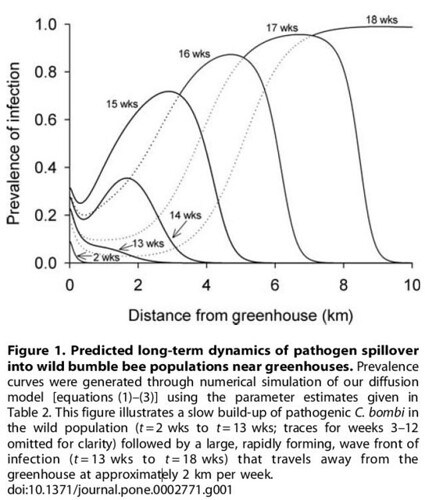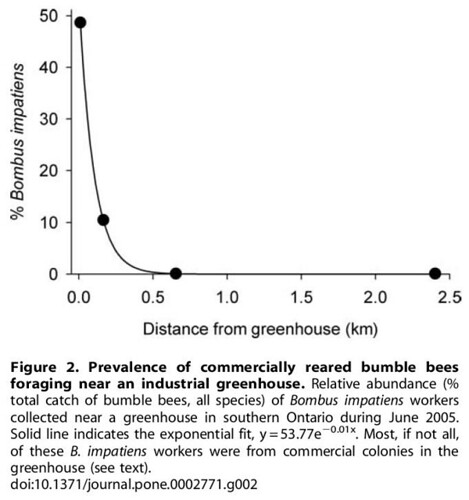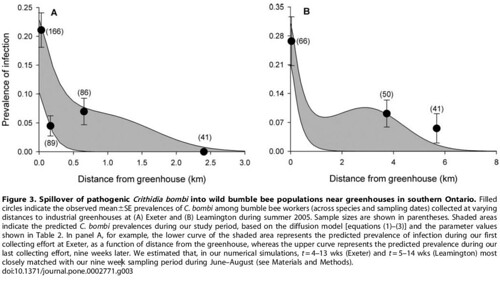tags: researchblogging.org, Bombus impatiens, Bumblebees, pathogen spillover, epidemiology, pollinating insects, greenhouses
Common Eastern Bumblebee, Bombus impatiens.
This species is often relied upon to pollinate commercial food crops,
such as tomatoes, that are often grown in agricultural greenhouses.
A mysterious decline in North American bumblebee populations is apparently the result of "spillover" of pathogen-infected commercial bumblebees, Bombus species, from agricultural greenhouses where tomatoes, peppers and cucumbers are commonly grown in huge quantities. Unlike the introduced European honeybee, Apis mellifera, which suffers from "colony collapse disorder" caused by a deadly virus that was accidentally introduced from Australia, bumblebees are endemic to the Americas, so the sharp decline in their populations not only endangers our food supply, but also affects the total biodiversity of flowering native plants and ultimately endangers all the insects and animals that depend upon them.
Even though tremendous sums of money are routinely invested into researching zoonotic infections, such as HIV/AIDS, H5N1 Avian Influenza, and Severe Acute Respiratory Syndrome (SARS), epidemics of introduced pathogens that affect wildlife are typically ignored, even when wild populations are being devastated. Wild insect populations are even less likely to attract attention.
A team of scientists from the University of Toronto is investigating the contagious bumblebee intestinal pathogen, Crithidia bombi, in an attempt to increase our knowledge of epidemiology in wild insect populations. C. bombi is an exotic pathogen that has apparently been introduced into wild populations by native bumblebees that are commercially raised in Europe and imported back into North America to provide industrial pollination services. Wild bumblebees, which have never experienced this pathogen before, began declining severely by the late 1990s.
The research team, consisting of evolutionary ecologists, Michael Otterstatter and James Thomson from the University of Toronto, report that C. bombi infects up to 75 percent of the wild bumblebees nesting near commercial greenhouses, depending on the time of year and the host Bombus species. But this pathogen is never found in wild bumblebees that nest far away from greenhouses.
After observing that commercial bumblebees regularly flew in and out of vents of two commercial agricultural greenhouses near Ontario, Otterstatter and Thomson wondered if this "spillover" was the source of exotic diseases that affect the health of wild bumblebees living nearby.
They designed a mathematical model to describe how disease would spread into the wild population from a focal point such as an agricultural greenhouse. Their mathematical model predicted two things: first, there would be a relatively slow increase of infection in nearby wild bumblebee populations that would build up over weeks or months which would eventually culminate in an epidemic wave that would affect nearby wild bumblebees. Second, their mathematical model predicted that infection rates among wild bumblebees would be correlated with the distance that their hive is located from a greenhouse: the greater the distance from a greenhouse, the lower their infection rate (figure 1);
Both predictions make inuitive and mathematical sense even when one thinks about them empirically.
To test their model, Otterstatter went into the field near several agricultural greenhouses and captured bumblebees that were foraging with butterfly nets, put them into vials and carried them back to the laboratory to screen for pathogens, and also examined their feces.
They found that bumblebees foraging nearest to the greenhouses were mostly "spillover" from the greenhouse, but their numbers fell off steeply with distance from the greenhouse (figure 2);
After collecting data for nine weeks, Otterstatter and Thomson found that their mathematical model accurately predicted that the prevalence of infection with the C. bombi pathogen was tightly correlated with distance from a commercial greenhouse (figure 3);
DOI: 10.1371/journal.pone.0002771 [larger view].
Otterstatter and Thomson found that 89 percent of commercial bee colonies in the study greenhouses were infected with the pathogen, C. bombi, that wild bumblebees commonly shared flowers with commercial bumblebees, and that could be the primary source for infection among wild bees. Otterstatter also examined wild bumblebees located near a commercial greenhouse that had ceased using industrial bumblebees to pollinate their crops. These wild bumblebees were free of infection with this exotic pathogen.
Otterstatter also found that C. bombi infections were more intense among individuals located near agricultural greenhouses, and the population dynamics of bumblebees infected with this pathogen mirrored infections with a second pathogen, the microsporidian Nosema bombi, that he identified in bumblebees at one of the study greenhouses.
"All of the different species of bumblebees that we sampled around greenhouses showed the same pattern: really high levels of infection near greenhouses and then declining levels of infection as you moved out," reports Otterstatter. "It was quite obvious that this was coming from the greenhouses and it was a general adverse effect on the bumblebees."
Otterstatter and Thomson's research clearly shows that lack of careful management of industrial bumblebees by agriculture is jeopardizing wild populations. Additionally, this problem can be prevented easily and cheaply.
"Regardless of the mechanism(s), spillover would be reduced, or perhaps even eliminated, if greenhouses were modified to prevent the cross-traffic of commercial and wild bees," write Otterstatter and Thomson. "Simple mesh screens, fitted to the ventilation systems of greenhouses, would minimize both the loss of costly commercial pollinators and the entrance of wild species."
Source
Otterstatter, M.C., Thomson, J.D., Adler, F.R. (2008). Does Pathogen Spillover from Commercially Reared Bumble Bees Threaten Wild Pollinators? PLoS ONE, 3(7), e2771. DOI: 10.1371/journal.pone.0002771.
- Log in to post comments





We import bees native to North America from commercial breeding operations in Europe and bring a disease back?
Too bad North American keepers of honeybees cannot branch into bumblebee propagation and keep the European disease out of our native bee population.
...wild bumblebees located near a commercial greenhouse that had ceased using industrial bumblebees to pollinate their crops. These wild bumblebees were free of infection with this exotic pathogen.
At least this part looks like (relatively) good news - the pathogen does not seem to have established itself in the wild (yet?).
I'm not a professional biologist, but I have to wonder what people are thinking when they deliberately transport animals (and plants) long distances, and then release them in the wild. Seems that we have enough trouble with the accidentally transported ones.
I hadn't read this until now. I'm in the Canadian Maritimes, and don't live close to a commercial greenhouse, but finding a soaking wet dead bumblebee hanging in one of my Hosta flowers yesterday gave me a twinge of anxiety. I know the bee likely died of age, or a traumatic encounter with a predator, but then I see yet another article about the fragile nature of wild populations...
Do you know if these commercial greenhouses spray pesticides? I just did a blog post based on this article from the British newspaper, The Guardian: http://www.guardian.co.uk/environment/2008/may/23/wildlife.endangeredsp…
It basically says that Germany and France have banned the use of 2 pesticides manufactured and sold by Bayer that have been proven to kill honeybees and even in the U.S. the same thing is found to be happening and there is a lawsuit from the 1990's still going on from N. Dakota beekeepers against Bayer and these pesticides that have been shown to kill off their honeybees.
Interesting that the Toronto study doesn't mention pesticide use at all in the greenhouses only that the closer to a greenhouse, the more they die from possible parasites and the further away they are, the healthier they are.